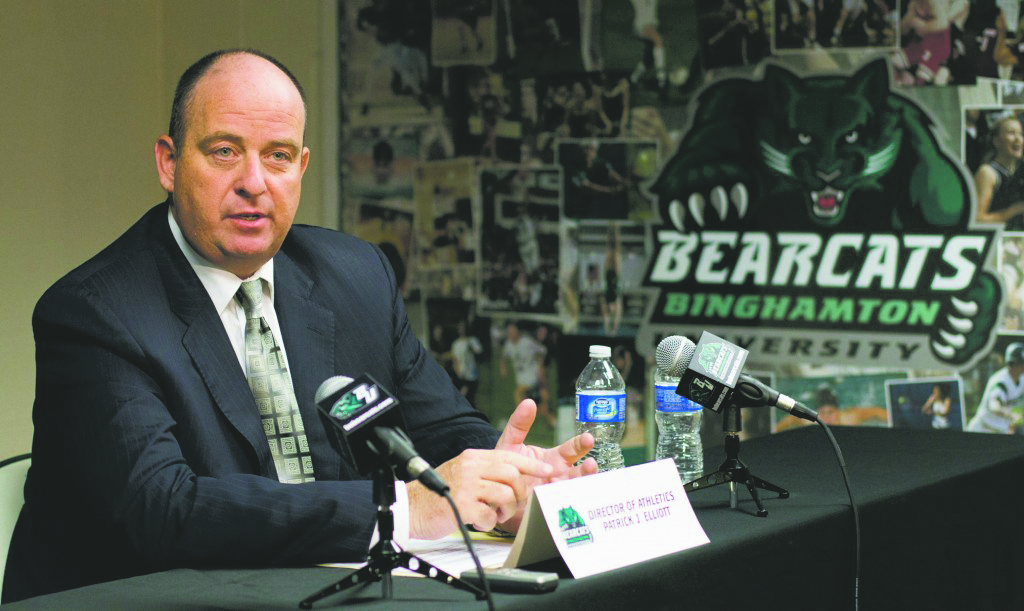
Winning back-to-back America East Championships to advance to the Division I Baseball NCAA Tournament was an impressive feat for the 2014 Binghamton baseball team. Such success brings acclaim and national attention to the program, and that in turn helps to draw recruits.
What an NCAA tournament appearance doesn’t bring, however, is direct revenue to the program: Unlike men’s basketball, baseball teams and other programs do not receive a payout from the conference when they secure a berth in the national championships.
“With the NCAA basketball tournament, appearances by institutions are compensated through the conference office, and then each conference office has separate policies of the distribution of the share,” said Patrick Elliot, BU director of athletics. “For baseball and actually all other championship sports within the NCAA, that’s not the same. They don’t use that model.”
They do, however, receive reimbursement for per diem costs and have all travel expenses covered by the NCAA through their travel agency, Shorts Travel.
So while the team’s lengthy trip to Stillwater, Okla. may have been more time consuming than previous NCAA appearances, it didn’t actually cost Binghamton any more than did the trip to Raleigh, N.C. last year or to Greenville, N.C. six years ago. Location and region do factor into regional placement decisions, but more important to the NCAA is ensuring that each region is fairly seeded, and that means certain teams will have to take a hike.
“With a 64-team field … they have to make sure that they distribute the seeding accordingly,” Elliott said. “There were a lot of Northeast conferences and East Coast conferences that got three and four seeds, which means that some of them are going to have to travel just to make sure that you have a balanced field at every site. So in this case, it was us, because in the last two appearances, we did stay on the east coast. In this case, they had us travel.”
That theory explains Binghamton’s placement in a Midwestern regional. But Binghamton didn’t receive any special notice to allow for more planning, nor would any team: Each team that secured an NCAA berth got word of its regional placement via national television, when the selection show was broadcast by ESPNU on Monday, May 26.
“We don’t find out until the whole world finds out,” Elliott said, “so we have the whole team in the Tau Bearcat Room watching on the big screen and waiting for our name to pop up. Once that occurs, then we’ll know where we’re going and who we’re playing.”
This year, the location was Stillwater, the opponent No. 7 Oklahoma State. Sharing the regional was two-seed and No. 19 Nebraska, as well as third-seeded Cal State Fullerton, a team Binghamton would not face.
According to NCAA rules, Binghamton would have to arrive on location by Thursday, leaving minimal time to plan travel.
“They always require participating teams to be at the site the day before the championships,” Elliot said. “That provides a practice day for our student-athletes as well as some various administrative meetings and coaches’ meetings that occur.”
Teams either book commercial flights or charter their own aircraft. BU opted to take a commercial flight out of Newark for this season’s trek. Leaving for New Jersey Wednesday afternoon, the team booked out to Tulsa and bused it to Stillwater. Requiring participating teams to arrive at the host institution at least a day in advance allows them to work off traveling stiffness, acquaint themselves with the field and get in some practice before their big games.
For the 2014 Binghamton team, those making the trip arrived in Stillwater on Thursday and then played their first game, against host Oklahoma State, at 7 p.m. the following day. Despite an obvious home-field advantage, one of the NCAA’s rule’s purposes is to abate any further advantage granted by minimal travel and regional proximity.
As for the rest of a baseball team’s costs, the expense falls to each individual school. Binghamton’s baseball program generates a very nominal income through ticket sales, a practice that was just started at the two-year-old Varsity Field last season. Additionally, the team will fundraise. However, for a program that does not have the same means to derive revenue as a program like men’s basketball, which produces more proceeds from guarantees – like the $90,000 it secured in participating in the 2014 Hall of Fame Tip-off – as well as ticket sales, concessions, marketing sales, corporate marketing advertising, and other means, it might seem that those avenues are insufficient.
But what BU’s men’s basketball is able to raise through its means is not put aside solely for that one program – the funds are divided throughout all of the school’s 21 programs.
“That’s how we’re able to pay for other sports that don’t necessarily have the wherewithal to generate the type of revenue that basketball might be able to,” Elliott said.
So through the BU athletic department’s general funding, things like the baseball team’s two or three weekend trips down south during the colder months of the season become less burdensome. Additionally, according to Elliott, the host institution will also usually provide some sort of financial aid, whether it be through discounted hotels or meals or even something like a $10,000 guarantee, intended to fray traveling costs. For a team usually unable to practice on its own field until late March, those weekend trips to the south – where it’s at least warm enough to play outside – help to keep the players fresh and ready to compete.


